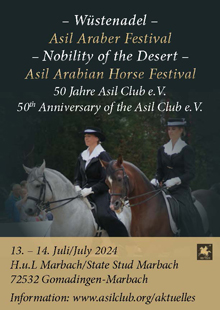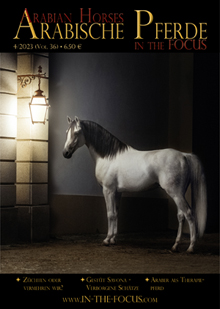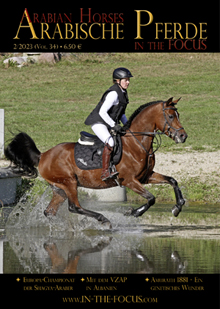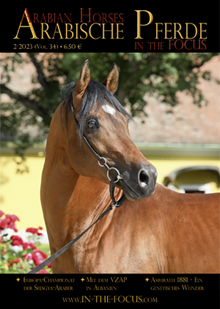One name pops up again and again, when it comes to the foundation horses of European Arabian horse breeding: Baron von Fechtig. But actually, there is little known about this illustrious merchant, who imported Original Arabs from the Orient, that have decisively influenced many European Studs at the beginning of the 19th century.
Basically, Baron von Fechtig came from Baden in South-West Germany, as he was born 1784 with the naem of Ferdinand Fechtig at Freiburg / Breisgau. His father, Ferdinand Johann Fechtig (sen.) was a judicial officer. Some time later, the course of his father’s work took the whole family to Vienna. There, in 1813, the father received for his services the title of “Baron von Fechtenberg” – and so, he called himself Freiherr Ferdinand Johann Fechtig von Fechtenberg. Fechtig sen. rose within the Austrian judiciary to become First President of Justice (1829) and representative of the judicial section in the State Council, a position which he occupied until his death in 1837.
Trade with the Orient
There is not much known about the professional and personal career of the son, Freiherr (Baron) Ferdinand von Fechtig (jun.), until he married Therese Countess Cassis-Faraone in Trieste, on 28th February 1808. She came from a wealthy merchant family from Trieste; her father was Anton Count Cassis-Faraone, her mother Thekla di Gibarra.
Most likely, it was due to his marriage with Therese Countess Cassis-Faraone, that Baron von Fechtig became a merchant, too. Especially, as his father-in-law was a former general tax collector for the Bey of Egypt, who then bought part of a trading company Balletti, Zaccar & Co. at Trieste a company operating in trade with Egypt.
Thanks to his connections with Arabian countries – Count Cassis-Faraone himself was born in Damascus, his wife came from Egypt -, Count Cassis developed the idea, together with some other lovers of Oriental horses, to buy horses directly in the Arab countries, to sell them in Europe. That’s what we read in Michael Erdelyi’s book*. But Anton Count Cassis-Faraone died already in 1805, whether or not he could realize his idea, we don’t know. When Baron von Fechtig married his daughter in 1808, it took a further five or six years, until the first horses came to Europe by the merchant house of Fechtig. It was finally Fechtig, who carried out the idea of Count Cassis, and according to Erdelyi, before that, he had undertaken several business trips to Aleppo, Damascus and Cairo. However, the first transport of horses from Cairo arrived in 1810 or 1811 in Trieste.
There are contradictory statements about the arrival of the individual horse transports of Fechtig, as well as about the number of horses, that found their way to Europe this way. The first transport of four stallions is said to have arrived 1810 or 1811 in Trieste; the horses were sold to the Counts Esterhazy and Festetics. Another transport arrived in April 1812. This second transport included the flea-bitten grey stallion Tajar Or.Ar., which was purchased for the amount of 1500 Ducats by Count Hunyady for his stud at Ürmeny (see AP 3/2015).
Tajar was considered one of the best stallions, that had ever set foot on Hungary and was famous soon after even beyond the borders. His fame and his quality have certainly helped Baron von Fechtig, to make a name as a horse-importer. As proof of Tajar’s quality, it was mentioned that King William I. of Wurttemberg bought a son of him as a riding horse, the grey Gemil-Tajar out of the Original-Arab mare Gemil Or.Ar.. Also the Duke of Baden and his aid bought a son each of Tajar Or.Ar. with the same name. Even if, in the beginning, it was only the Hungarian nobility which was interested in Fechtig’s horses, soon after the Kings of Württemberg and Bavaria as well as the Emperor of Austria were also among his customers.
Royal Customers
Together with the mentioned flea-bitten grey Tajar, Count Hunyady also bought the golden bay stallion Saffir Or.Ar. and two mares, Gemil Or.Ar. and Troitti Or.Ar., who arrived with the second transport. While still in Trieste, Baron von Fechtig bred a stallion of the name Mezahar Or.Ar., who also arrived with this transport, to the mare Gemil Or.Ar., of which a filly resulted which was born the next year at the Ürmeny stud of Count Hunyady. Mezahar Or.Ar. however, was sold to King William of Württemberg (still a Crown Prince) where he was used as chief sire from 1815 at his stud in Scharnhausen.
Of the third transport of Baron von Fechtig, which arrived at Triest in 1814, the Crown Prince of Württemberg bought the stallion Emir Or.Ar. It is known, that this bay stallion was purchased from the Bedouin tribe Anazé in the area of the Lebanon. When he arrived in Württemberg, he first served as personal mount of the Crown Prince before he was used in breeding; he later became the foundation sire of the carriage horses at the Royal Stud of Weil.
It is interesting, that for the following transports, Baron von Fechtig did not travel to the Orient himself to buy horses. Hörmann** reports: “Only in the year 1815, the Baron started to make use of a veterinarian, who went with the French Army under Napoleon to Egypt, and while the army retreated, he remained. This veterinarian was sent to Aleppo and Damascus, to travel from there further inland where the Arab tribes lived, and to purchase pure Arab stallions and mares. The first transport of this kind arrived in 1816, and included the foundation stock of the presently existing stud [of Baron von Fechtig]. Until the year 1822, said man carried out more purchases and transports.” And the New Monthly Magazin*** reported: “There is the erroneous view in Europe, that there are numerous studs of horses in the deserts of Arabia. A breeder seldom possesses more than 30, or at most 40 head, which he values very highly, and of which he keeps an exact pedigree. The late wars and disturbances have exceedingly raised the prices of these animals; so that entire horses of the best breeds now cost on the spot from 8 to 10,000 piastres each. Count Hunyady of Hungary has lately obtained two of these rare creatures, purchased near Aleppo, through the agency of the house of Fechtig, which is at this moment [1st February 1816] preparing to ship off eleven more, mainly mares, for Trieste.”
This transport, which arrived 1816 in Trieste, included the important foundation mare Muranan I Or.Ar. for Weil. This mare arrived pregnant in Wüttemberg, as it is mentioned that she gave birth to a foal of the stallion Tajar “Hunyady”. Therefore the imported horses must have been transported from Trieste to the Ürmeny Stud of Count Hunyady, about 650 km from Trieste, in the Komitat Neutra (today’s Slovakia), before they would start their journey to their new owners from there.
Foundation horses
 Two stallions of the transport of 1816, Siglavy Gidran Or.Ar. and Ebchan Or.Ar. were, together with the mare Tifle Or.Ar., sold to the Hungarian Military Stud of Bábolna. Where the other mares ended up, nobody knows. It is reported, that apart from Murana I Or.Ar. seven other mares were sold to Weil – Erdelyi even talks about ten to eleven – but these mares are nowhere to be found in the records of the Royal Stud of Weil.
Two stallions of the transport of 1816, Siglavy Gidran Or.Ar. and Ebchan Or.Ar. were, together with the mare Tifle Or.Ar., sold to the Hungarian Military Stud of Bábolna. Where the other mares ended up, nobody knows. It is reported, that apart from Murana I Or.Ar. seven other mares were sold to Weil – Erdelyi even talks about ten to eleven – but these mares are nowhere to be found in the records of the Royal Stud of Weil.
In 1817, the two stallions Bairactar Or.Ar. and the bay Tajar Or.Ar. arrived in Stuttgart. The two stallions together cost 4500 Ducats, payable in five instalments to Baron von Fechtig, i.e. far more than the famous flea-bitten grey Tajar. But the investment was worth it. The grey Bairactar Or.Ar. of the Saklawi Djedran strain was to become the pillar of the Weil breeding program (see AP 1/2015). The bay Tajar Or.Ar., also of the Saklawi Djedran strain, was used as sire extensively for 10 years, before he was sold to the Duke of Sachsen-Meiningen, because his offspring were considered to be too refined and difficult in temperament.
Trading with Cairo seemed to be paying off according to the New Monthly Magazine of 1817 where it was mentioned that “several trading companies from Europe, and, since some years, the great house of Fechtig from Austria, have established themselves at Cairo, where they are doing good business.”
Soon, Trieste, which was already one of the leading trading cities of the K.&K. Monarchy, also became the trading centre for Arabian horses, that arrived here by ship from Egypt and Syria. But such a transport of horses was a rather risky enterprise in these days, which was appreciated by the experts, who paid close attention to it. In this matter, Johann Nikolaus Rohlwes, a Royal Prussian Veterinarian at Friedrich-Wilhelm-Stud in Neustadt/Dosse wrote sympathetically about the project in 1822: “It appears, that Arabian horses in the future might become more easily available; because I have made the acquaintance of a traveler some years ago, who happened to be in Vienna for some time and he told me, that a trade company in Trieste made it one of its branches to buy Arabian stallions of the most noble breed, of which he had seen five at Vienna, and this man, who is selling these horses there, ensured him, that there are another eleven still at Trieste. A risky business, which can be of great advantage for the amelioration of horse breeding in Germany, and which will make the acquisition of these horses much cheaper, with almost no risk and danger involved, as it is the merchant who is taking all the risks.”
Good relations with Bábolna
A fourth transport by Baron von Fechtig followed in 1819. According to an agreement with the then Remount-Inspector General Count von Hardegg, these horses were brought first to the Military Stud of Bábolna, so that stud-owned mares could be covered with the new stallions. Also, food was cheap and selling the horses could be organised from Bábolna. But in 1820, Count Hunyady offered Baron von Fechtig an even better deal, so that he stabled his horses again at Ürmeny until they were sold.
In 1821, Baron von Fechtig sold four stallions to Count Palfy: Saklawy Or.Ar., Schebessian Or.Ar., Koheyl Or.Ar. and a stallion of his own breeding. In return, he got two properties near Kirchschlag, about 50 km South of Wiener Neustadt. Here, he established his own oriental stud, where he bred himself, but most likely stabled also any further imported horses until they found their buyer.
In the same year, the Royal Stud of Weil bought two more mares from Baron von Fechtig: The mares Czebessie I Or. Ar. and Hamdany I Or.Ar., the latter had a filly foal at foot, named Sady III, when she arrived in Weil. Sady III was to become a foundation mare for the stud. About Hamnday I Or.Ar. the following description by Prof. Rueff is handed down: “grey, of the strain Seglawi, 14 fist, 2 inches, bought for the stud from merchant Fechtig in Trieste in 1821; a noble and beautiful mare, with bound shoulder and fine front legs; she got a cataract and died in 1829.” About her filly Sady III, Prof. Rueff wrote: “Daughter of the above [Hamdany I], but the result of a covering in the stud of Baron Fechtig; by an Arabian stallion named Schwarzenberg in Bábolna; born 1821 in Weil; her breeding record was extraordinary… she had 10 colts and 8 fillies.”
Until the year 1822, the said veterinarian purchased horses on order of Fechtig in the Orient. With the last transport in 1822, the black stallion Mameluck Or.Ar. arrived in Triest and was received by the Royal Württemberg Chief veterinarian Dr. Hördt. The black stallion Mameluck Or.Ar. belonged to the Koheilan Adjouz strain and was bred to the mares of the carriage breed and with Trakehener mares; he became the founder of the black carriage horses at Weil.
Gudrun Waiditschka
(to be continued)













